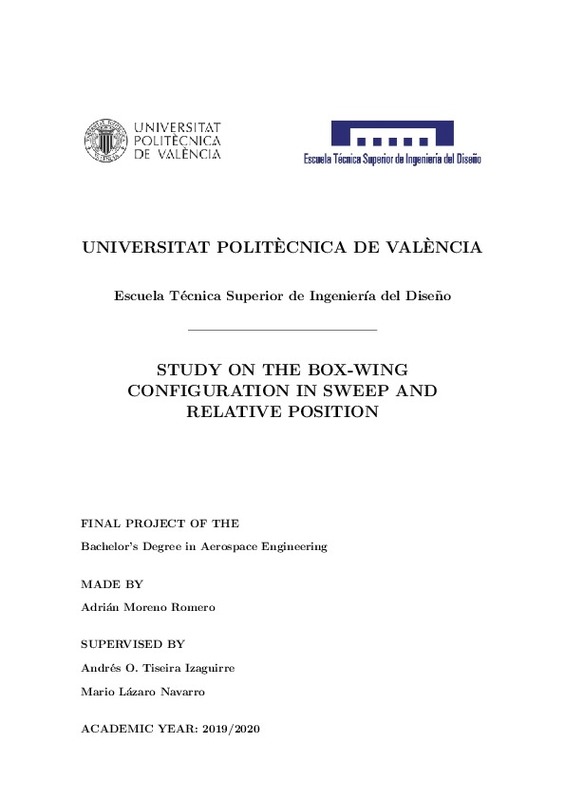JavaScript is disabled for your browser. Some features of this site may not work without it.
Buscar en RiuNet
Listar
Mi cuenta
Estadísticas
Ayuda RiuNet
Admin. UPV
Study on the box-wing configuration in sweep andrelative position
Mostrar el registro sencillo del ítem
Ficheros en el ítem
| dc.contributor.advisor | Tiseira Izaguirre, Andrés Omar
|
es_ES |
| dc.contributor.advisor | Lázaro Navarro, Mario
|
es_ES |
| dc.contributor.author | Moreno Romero, Adrián
|
es_ES |
| dc.date.accessioned | 2020-07-29T09:27:01Z | |
| dc.date.available | 2020-07-29T09:27:01Z | |
| dc.date.created | 2020-07-02 | |
| dc.date.issued | 2020-07-29 | es_ES |
| dc.identifier.uri | http://hdl.handle.net/10251/148799 | |
| dc.description.abstract | [EN] The main objective of this document is to study the box-wing configuration, representedby tandem fore-and-aft wings joined at their tips. To achieve this objective, the influenceof two of the fundamental parameters on the aerodynamic behavior of the airplane isanalysed: the sweep angle and the relative position of the wings. In addition, differentdihedral angles are also considered during the conceptual design of the aircraft.In order to carry out the study in a satisfactory manner, avoiding further dispersion inthe results, the same wing cross-sectional shape is maintained for both lifting surfaces,as well as the wingspan. Besides, the fuselage is considered to have no influence on theaerodynamic research.Finally, a preliminary static aeroelastic analysis in regard to the aircraft’s wing structureis proposed as possible guide for future projects.The tools used for the theoretical development of the work are the software STAR-CCM+R©and MatLabR©, and Tornado, a code for implementing a vortex-lattice method.The main results focus mainly on both aerodynamic coefficients and aerodynamic effi-ciency, as well as on the distributions of the velocity and pressure fields. In general terms,it can be concluded that the lift, and induced and parasitic drag aerodynamic coefficientsincrease as both, fore and aft, wing sweep angles decrease. If the relative height is re-duced, lift diminishes, but induced drag is increased. As for the aerodynamic efficiency,it increases if the relative position (both, longitudinally and vertically) between the wingsincreases. | es_ES |
| dc.description.abstract | [ES] El presente documento tiene como principal objetivo el estudio de la configuración box-wing, caracterizada por disponer de alas en tándem unidas por sus extremos. Para llevar acabo dicho objetivo, se analiza la influencia de dos de los parámetros fundamentales sobre el comportamiento aerodinámico del avión: el ángulo de flecha y la posición relativa de las alas. De manera complementaria, también se examinan distintos ángulos diedro durante el diseño conceptual de la aeronave. Para efectuar el estudio de manera satisfactoria y sin mayor dispersión en los resultados,se mantiene un mismo perfil alar en ambas superficies alares, así como también la enver-gadura. Además, se considera que el fuselaje no tiene incidencia sobre la investigación del a aerodinámica. Finalmente, se propone un análisis aeroelástico estático preliminar con respecto a la estructura del ala de la aeronave como posible guía para futuros proyectos. Las herramientas de cálculo utilizadas para el desarrollo teórico del trabajo son los software STAR-CCM+R© y MatLabR©, y Tornado, un código de implementación de un método vortex-lattice. Los principales resultados se centran, fundamentalmente, tanto en los coeficientes como en la eficiencia aerodinámica, así como también en las distribuciones de los campos develocidades y presión, y el análisis de la divergencia. En términos generales, se puedeconcluir que la sustentación y los coeficientes aerodinámicos de resistencia inducida y parásita aumentan a medida que disminuyen los ángulos de flecha de las alas, tanto en ladelantera como en la trasera. Si se reduce la altura relativa, la sustentación disminuye, pero aumenta la resistencia inducida. En cuanto a la eficiencia aerodinámica, aumenta si se incrementa la posición relativa (tanto longitudinal como vertical) de las alas. | es_ES |
| dc.format.extent | 113 | es_ES |
| dc.language | Inglés | es_ES |
| dc.publisher | Universitat Politècnica de València | es_ES |
| dc.rights | Reserva de todos los derechos | es_ES |
| dc.subject | Alas | es_ES |
| dc.subject | Box-wing | es_ES |
| dc.subject | Flecha | es_ES |
| dc.subject | Aerodinámica | es_ES |
| dc.subject | 2-D | es_ES |
| dc.subject | Wings | es_ES |
| dc.subject | Sweep | es_ES |
| dc.subject | Aerodynamic | es_ES |
| dc.subject | 2-D. | es_ES |
| dc.subject.classification | INGENIERIA AEROESPACIAL | es_ES |
| dc.subject.other | Grado en Ingeniería Aeroespacial-Grau en Enginyeria Aeroespacial | es_ES |
| dc.title | Study on the box-wing configuration in sweep andrelative position | es_ES |
| dc.title.alternative | Estudio sobre la configuración box-wing en flecha y posición relativa | es_ES |
| dc.type | Proyecto/Trabajo fin de carrera/grado | es_ES |
| dc.rights.accessRights | Abierto | es_ES |
| dc.contributor.affiliation | Universitat Politècnica de València. Departamento de Máquinas y Motores Térmicos - Departament de Màquines i Motors Tèrmics | es_ES |
| dc.contributor.affiliation | Universitat Politècnica de València. Escuela Técnica Superior de Ingeniería del Diseño - Escola Tècnica Superior d'Enginyeria del Disseny | es_ES |
| dc.description.bibliographicCitation | Moreno Romero, A. (2020). Study on the box-wing configuration in sweep andrelative position. Universitat Politècnica de València. http://hdl.handle.net/10251/148799 | es_ES |
| dc.description.accrualMethod | TFGM | es_ES |
| dc.relation.pasarela | TFGM\132459 | es_ES |
Este ítem aparece en la(s) siguiente(s) colección(ones)
-
ETSID - Trabajos académicos [8909]
Escuela Técnica Superior de Ingeniería del Diseño






